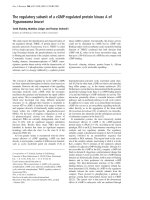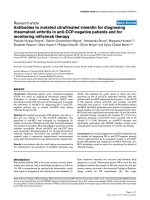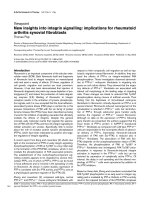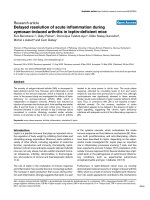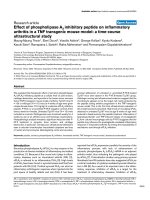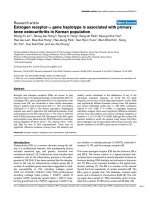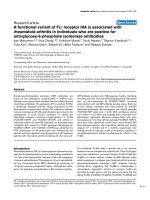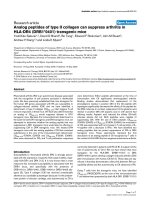Báo cáo y học: "The ITGAV rs3738919-C allele is associated with rheumatoid arthritis in the European Caucasian population: a family-based study" docx
Bạn đang xem bản rút gọn của tài liệu. Xem và tải ngay bản đầy đủ của tài liệu tại đây (134.33 KB, 7 trang )
Open Access
Available online />Page 1 of 7
(page number not for citation purposes)
Vol 9 No 4
Research article
The ITGAV rs3738919-C allele is associated with rheumatoid
arthritis in the European Caucasian population: a family-based
study
Laurent Jacq
1,2
, Sophie Garnier
1
, Philippe Dieudé
1,3
, Laëtitia Michou
1,4
, Céline Pierlot
1
, Paola Migliorini
5
,
Alejandro Balsa
6
, René Westhovens
7
, Pilar Barrera
8
, Helena Alves
9
, Carlos Vaz
9
, Manuela Fernandes
9
,
Dora Pascual-Salcedo
6
, Stefano Bombardieri
5
, Jan Dequeker
7
, Timothy R Radstake
8
, Piet Van Riel
8
,
LeovandePutte
8
, Antonio Lopes-Vaz
9
, Elodie Glikmans
1
, Sandra Barbet
1
, Sandra Lasbleiz
1,4
,
Isabelle Lemaire
1,2
, Patrick Quillet
1,2
, Pascal Hilliquin
1,2
, Vitor Hugo Teixeira
1,10
, Elisabeth Petit-Teixeira
1
,
Hamdi Mbarek
1
, Bernard Prum
11
, Thomas Bardin
1,4
, François Cornélis
1,2,12
for the European Consortium on Rheumatoid Arthritis Families
1
GenHotel-EA3886, Evry-Paris VII Universities, Member of the AutoCure European Consortium, 2 rue Gaston Crémieux, 91057 Evry-Genopole
cedex, France
2
Centre Hospitalier Sud Francilien, 59 bd Henri Dunant, 91100 Corbeil-Essonnes, France
3
Service de rhumatologie, Hôpital Bichat, AP-HP, 46 rue Henri Huchart, 75018 Paris, France
4
Service de rhumatologie, Hôpital Lariboisière, AP-HP, 2 rue Ambroise Paré, 75010 Paris, France
5
Pisa University, 56126 Pisa, Italy
6
La Paz Hospital, 28046 Madrid, Spain
7
Katholieke Universiteit Leuven, BE-3000 Leuven, Belgium
8
Nijmegen University, 6500HB Nijmegen, The Netherlands
9
Porto San Joao Hospital, 4200 Porto, Portugal
10
Faculty of Medicine, University of Coimbra, Coimbra, Portugal
11
Laboratoire Statistique et Génome, Genopole, Tour Evry 2, 91000 Evry, France
12
Unité de Génétique Clinique, Hôpital Lariboisière, AP-HP, 2 rue Ambroise Paré, 75010 Paris, France
Corresponding author: Laurent Jacq,
Received: 22 Feb 2007 Revisions requested: 20 Apr 2007 Revisions received: 9 May 2007 Accepted: 3 Jul 2007 Published: 3 Jul 2007
Arthritis Research & Therapy 2007, 9:R63 (doi:10.1186/ar2221)
This article is online at: />© 2007 Jacq et al.; licensee BioMed Central Ltd.
This is an open access article distributed under the terms of the Creative Commons Attribution License ( />),
which permits unrestricted use, distribution, and reproduction in any medium, provided the original work is properly cited.
Abstract
The integrin αvβ3, whose αv subunit is encoded by the ITGAV
gene, plays a key role in angiogenesis. Hyperangiogenesis is
involved in rheumatoid arthritis (RA) and the ITGAV gene is
located in 2q31, one of the suggested RA susceptibility loci.
Our aim was to test the ITGAV gene for association and linkage
to RA in a family-based study from the European Caucasian
population.
Two single nucleotide polymorphisms were genotyped by PCR-
restriction fragment length polymorphism in 100 French
Caucasian RA trio families (one RA patient and both parents),
100 other French families and 265 European families available
for replication. The genetic analyses for association and linkage
were performed using the comparison of allelic frequencies
(affected family-based controls), the transmission disequilibrium
test, and the genotype relative risk.
We observed a significant RA association for the C allele of
rs3738919 in the first sample (affected family-based controls,
RA index cases 66.5% versus controls 56.7%; P = 0.04). The
second sample showed the same trend, and the third sample
again showed a significant RA association. When all sets were
combined, the association was confirmed (affected family-
based controls, RA index cases 64.6% versus controls 58.1%;
P = 0.005). The rs3738919-C allele was also linked to RA
(transmission disequilibrium test, 56.5% versus50% of
transmission; P = 0.009) and the C-allele-containing genotype
was more frequent in RA index cases than in controls (RA index
cases 372 versus controls 339; P = 0.002, odds ratio = 1.94,
95% confidence interval = 1.3–2.9).
The rs3738919-C allele of the ITGAV gene is associated with
RA in the European Caucasian population, suggesting ITGAV
as a new minor RA susceptibility gene.
AFBAC = affected family-based controls; bp = base pair; GRR = genotype relative risk; PCR = polymerase chain reaction; RA = rheumatoid arthritis;
SNP = single nucleotide polymorphism; TDT = transmission disequilibrium test.
Arthritis Research & Therapy Vol 9 No 4 Jacq et al.
Page 2 of 7
(page number not for citation purposes)
Introduction
Rheumatoid arthritis (RA) is the most common human sys-
temic autoimmune disease (0.8% prevalence in the European
Caucasian population), affecting women preferentially [1]. The
disease is characterized by a chronic inflammation of the syn-
ovial tissues leading to the formation of the rheumatoid pan-
nus, which erodes adjacent cartilage and bone, causing
subsequent joint destruction. One hallmark of the pannus is
hyperangiogenesis [2].
Previous studies have indicated that the risk of developing the
disease in siblings of affected individuals is 2–17 times higher
than in the general population, suggesting the importance of
genetic factors [1]. Two RA genes have so far been estab-
lished and confirmed using familial material, HLA-DRB1 and
PTPN22 [3,4], but they account only for a part of the RA
genetic component. The dense genome scan realized in our
laboratory suggested 19 non-HLA regions in the French Cau-
casian population [5] and one of these, 2q31, contains the
ITGAV gene (alias CD51,
α
v), which encodes the αv subunit
of the integrin family. This family is composed of at least 24
heterodimeric combinations of 18 α subunits and nine β sub-
units. These transmembranous receptors are expressed at the
surface of numerous cells (endothelial cells, macrophages,
monocytes, osteoclasts, platelets) and recognize the RGD
sequence (Arg–Gly–Asp) of many ligands (such as vitronec-
tin, fibronectin, osteopontin, sialoprotein, thrombospondin,
fibrinogen, von Willebrand factor, tenascin, agrin, matrix metal-
loproteinases, and prothrombin) [6]. The integrins are involved
in several functions including adhesion of activated endothelial
cells with the extracellular matrix, proliferation, migration, and
differentiation signals of vascular cells [6].
The αvβ3 integrin is well documented to play a key role in ang-
iogenesis, and the ITGAV knockout animal model is lethal in
utero for 80% with a presence of large vascular anomalies
[7,8].
Angiogenesis also plays a key role in RA when the synovial
membrane becomes hyperplasic and destroys the cartilage.
We can observe an excess of blood cells (macrophages, T
lymphocytes) in the synovial membrane and fluid, and some
αvβ3 ligands (that is, fibrinogen or osteopontin) are abundant
in the RA synovial fluid [7]. Moreover, some proangiogenic
mediators (that is, vascular endothelial growth factor) are over-
expressed in RA synovial membrane and serum [9,10].
In addition, several αvβ3 antagonists and angiogenesis inhibi-
tors have been successfully tested on RA animal models [11-
14]. The αvβ3 integrin could therefore become a new thera-
peutic target in RA, and some clinical studies have already
begun [15].
Our aim was to use RA familial material to test two intronic
ITGAV single nucleotide polymorphisms (SNPs) for RA asso-
ciation and linkage in the European Caucasian population.
Materials and methods
All subjects provided informed consent, and the ethics com-
mittee of Hôpital Bicêtre (Kremlin-Bicêtre, Assistance Pub-
lique-Hôpitaux de Paris, France) approved the study. RA
families were recruited through a national media campaign fol-
lowed by selection of individuals who fulfilled the 1987 Amer-
ican College of Rheumatology criteria for RA according to the
physicians in charge of the patients [16]. A rheumatologist uni-
versity fellow reviewed all clinical data.
Sample 1
Sample 1 (Table 1) constituted the DNA from 100 French
Caucasian unrelated trio families (one RA patient and both
parents) with the four grandparents of French Caucasian ori-
gin. Among these 100 RA patients, 87 were women; their
mean age at disease onset was 32 years. In total, 81 patients
were rheumatoid factor positive, 78 patients carried at least
one HLA-DRB1 'shared epitope' susceptibility allele
(DRB1*0101, DRB1*0102, DRB1*0401, DRB1*0404,
DRB1*0405, DRB1*0408, DRB1*1001) [17] and 90 patients
presented erosion.
Table 1
Characteristics of rheumatoid arthritis (RA) index cases from the investigated samples
Sample 1 (n = 100) Sample 2 (n = 100) Sample 3 (n = 265)
Females (%) 87 90 86
Mean age of disease onset (years) (±standard deviation) 32 (±10) 31 (±6) 30 (±9)
Mean disease duration (years) (±standard deviation) 18 (±7) 16 (±8) 8 (±7)
RA patients with bone erosions (%) 90 79 72
RA patients seropositive for rheumatoid factor (%) 81 76 73
RA patients carrying at least one HLA-DRB1 shared epitope allele (%) 78 80 Not available
n, number of cases.
Available online />Page 3 of 7
(page number not for citation purposes)
Sample 2
Sample 2 (Table 1) was made up of the DNA from another 100
French Caucasian unrelated trio families with the same char-
acteristics as sample 1. Among these 100 RA patients, 90
patients were women; their mean age at disease onset was 31
years. In all, 76 patients were rheumatoid factor positive, 80
patients carried at least one HLA-DRB1 shared epitope and
79 patients had an erosive disease.
Sample 3
Sample 3 (Table 1) contained the DNA from 265 European
Caucasian unrelated trio families with the same characteristics
as sample 1, except for a shorter mean disease duration and a
different ethnic origin (Caucasian families from France, Italy,
Portugal, Spain, Belgium, and The Netherlands).
Genotyping
DNA was isolated and purified from whole blood according to
standard protocols [18]. Two intronic SNPs were selected at
the 5' and 3' ends of the gene with a minor allele frequency
>25% for European population databases. Moreover the pres-
ence of a restriction site for one of the alleles was required
(SNP1, rs3768777; SNP2, rs3738919 [19,20]). Genotyping
was performed by the PCR followed by restriction fragment
length polymorphism method [21].
The designed primers were: sense, 5'-AAGTTGCCAACGT-
TCCGCGTTGCA-3' and antisense, 5'-GTAGTAGAAGAT-
GGTCCTATCCACG-3' for SNP1; and sense, 5'-
ATTTCCAGGTGGAACTTCTTTTGGA-3' and antisense, 5'-
TCACAATTCAGATTTTTGCCACTGG-3' for SNP2.
PCR amplification of SNP1 and SNP2 was performed on each
sample in a 25 μl reaction volume consisting of 10 U PCR
buffer (Perkin Elmer, Boston, MA, USA), 1.25 mM each dNTP,
1.25 U AmpliTaq Gold DNA polymerase (Applied Biosystems,
Foster City, CA, USA), 3 mM MgCl
2
, 0.0125 nM of the two
primers and 50 ng genomic DNA, diluted to the final volume
with H
2
O on an Eppendorf thermocycler using a hot start pro-
cedure. The PCR program was carried out using a first dena-
turation cycle of 94°C for 10 minutes followed by 37 cycles of
denaturation at 94°C for 40 seconds, with an annealing tem-
perature at 67°C for 30 seconds followed by an elongation
step at 72°C for 1 minute. One final cycle of the extension was
performed at 72°C for 2 minutes.
For SNP1, a 341-bp amplified fragment was digested with
NlaIII, generating two fragments when the restriction site was
present (A allele). For SNP2, the resulting 501-bp fragment
was digested with AluI, generating three fragments for the C
allele (126 bp, 161 bp and 214 bp), and two fragments for the
A allele (permanent restriction site allowing one to validate the
restriction protocol; 161 bp and 340 bp). Genotypes were
assessed blindly by two independent investigators (LJ and
CP). CEPH controls (1347-02 and 884-15) and 40 patients
chosen at random were genotyped for quality control. All gen-
otype data will be available online [22].
Power calculation
Using the European population minor allele frequency of 29%
and 35% for SNP1 and SNP2, respectively, a sample size of
100 patients and 100 controls, and the arc sinus transforma-
tion method described by Garnier and colleagues [23], we
had 80% power to detect an association (P < 0.05) if the dif-
ference in allelic frequencies between patients and controls
was at least 11% for SNP1 and 12.2% for SNP2.
Statistical analysis
Prior to association tests, we checked the Hardy–Weinberg
equilibrium in 'virtual controls' (constituted by parental untrans-
mitted alleles to RA index cases).
The association and linkage between each polymorphism and
RA was examined by three different methods: the affected
family-based controls (AFBAC) method was used to compare
transmitted and untransmitted allelic frequencies across all
families, the transmission disequilibrium test (TDT) was used
to detect linkage through preferential transmission of one
allele to the affected subjects, and the genotype relative risk
(GRR) test was used to compare the genotypic distribution in
patients and controls [24-26]. The significance of the P value
was assessed at 5%, leading to replication tests in sample 2
and, in the case of relevant results, in the larger sample 3.
Results
Hardy–Weinberg equilibrium
Hardy–Weinberg equilibrium in the virtual controls was
respected for SNP1 and SNP2 in sample 1 and in the replica-
tion samples (data not shown).
Test for association and linkage in sample 1
We observed neither significant association nor linkage
between SNP1 and RA in sample 1. For SNP2, we observed
a significant association for the C allele and a strong trend for
a RA linkage (AFBAC, RA index cases 66.5% versus controls
56.7%, P = 0.04; TDT, 59.7% of transmission versus 50%, P
= 0.06) (Table 2). The GRR test showed a significant increase
of the C/C genotype and an excess of C-allele-containing gen-
otypes in patients (Table 3).
The linkage disequilibrium test showed a weak linkage dise-
quilibrium between SNP1 and SNP2 (D' = 0.33), and were
thus considered independent. The results of the haplotypic
TDT analysis showed a significant undertransmission of the
SNP1/SNP2 GA haplotype (21 versus 37, P = 0.03), and a
trend for an overtransmission of the two haplotypes containing
the C allele of SNP2 (data not shown).
Arthritis Research & Therapy Vol 9 No 4 Jacq et al.
Page 4 of 7
(page number not for citation purposes)
When stratifying the sample for the families with the index pre-
senting at least one PTPN22-620W allele or the HLA-DRB1
allele shared epitope status, no correlation with the ITGAV
genotypes could be observed (data not shown).
Test for association and linkage in sample 2
The significant association observed for SNP2 in sample 1 led
to a replication test in a second set of 100 French Caucasian
Trio families (sample 2) on the hypothesis of an association of
the C allele.
In this sample, we observed a trend for association and linkage
of the C allele with RA (AFBAC, RA index cases 63.1% versus
controls 59.6%, P = 0.4; TDT, 52.6% of transmission, P =
0.6) (Table 4). The GRR test showed a trend for an excess of
the C-allele-containing genotype in RA index cases compared
with controls (90 RA index cases versus 79 controls, P =
0.09) but not for the C/C genotype (Table 5).
The combination of the two samples, authorized by the
absence of any significant clinical difference between them,
showed a marginally significant association of the C allele
(AFBAC, RA index cases 64.8% versus controls 58.2%, P =
0.05; TDT, 56.1% of transmission, P = 0.09) and a significant
excess of the C-allele-containing genotype in RA index cases
compared with controls (173 RA index cases versus 157 con-
trols, P = 0.02).
Test for association and linkage in sample 3
The trend for association of the C allele observed in sample 2
was in the same direction as the significant association
observed in sample 1, without reaching statistical significance
– notably due to a lack of power (the power to detect a signif-
icant association in sample 2, based on the allelic frequencies
in sample 1, with P < 0.05, was only 51%). A larger replication
test (265 families, sample 3) was therefore conducted on the
hypothesis of an association of the C allele and of the C-allele-
containing genotype.
Table 2
Affected family-based control and transmission disequilibrium test analyses for single nucleotide polymorphism (SNP)1 and SNP2
in sample 1 of rheumatoid arthritis trio families
Allele Affected family-based controls Transmission disequilibrium test
Rheumatoid
arthritis cases
Controls P Transmission (%) nP
SNP1
A 0.360 0.320 0.39 54.4 90 0.39
G 0.640 0.680
SNP2
C 0.665 0.567 0.04 59.7 92 0.06
A 0.335 0.433
n, number of heterozygote parents.
Table 3
Genotype relative risk analysis for single nucleotide polymorphism (SNP)1 and SNP2 in sample 1 of rheumatoid arthritis trio
families
Genotype Rheumatoid arthritis cases Controls P
SNP1
A/A 16 7 0.1 (global)
A/G 40 50
G/G 44 43
SNP2
C/C 45 32 0.03 (C/C versus C/A + A/A)
C/A 38 46 0.36 (C/C + C/A versus A/A)
A/A 13 18
Available online />Page 5 of 7
(page number not for citation purposes)
We observed a significant RA association and linkage for the
C allele (AFBAC, RA index cases 64.4% versus controls
57.8%, P = 0.03; TDT, 57% of transmission versus 50%, P =
0.04) (Table 6). This increase was supported by a significant
increase of the C-allele-containing genotype in patients (199
RA index cases versus 182 controls, P = 0.02) (Table 7).
Test for association and linkage in the combined
samples 1 + 2 + 3
The combination of the three samples, authorized by the
absence of a significant clinical difference between them, con-
firmed association and linkage for the C allele (AFBAC, 64.6%
versus 58.1%, P = 0.005; TDT, 56.5% of transmission, P =
0.009) (Table 8). The GRR test showed an excess of the C-
allele-containing genotype in patients (372 RA index cases
versus 339 controls, P = 0.002, odds ratio = 1.94, 95% con-
fidence interval = 1.3–2.9) (Table 9).
Discussion
We studied the ITGAV gene, a good RA candidate gene for
its function implicated in angiogenesis, and its chromosomal
location (in one of the 19 suggested non-HLA loci of our
dense genome scan) [5]. We observed a significant RA asso-
ciation for the C allele of rs3738919 in a first sample of French
Caucasian families, the same trend in replication sample 2,
and again a significant association in replication sample 3
(European Caucasian families). Finally, significant RA associa-
tion and linkage were observed when all sets were combined.
The association and linkage evidences provided by the
present study remain nevertheless statistically modest, sug-
gesting at most a minor RA susceptibility marker. Further stud-
ies in independent samples will be needed to definitively
establish association and linkage of the ITGAV rs3738919-C
allele to RA. For the observed allelic frequencies of 64.6% in
patients versus 58.1% in controls, a sample size of 350 fami-
lies would be required to obtain, with 80% power (P < 0.05),
an independent replication of the association evidence
reported here.
Once this association had been replicated, resequencing
would be necessary to identify exonic and promoter SNPs to
refine the associated haplotype.
In the same way, the chromosome 2 linkage suggestion
observed in the genome scan of our laboratory could not be
totally explained by the findings of the ITGAV linkage; hence,
with the overtransmission observed in the TDT, the allele shar-
ing expected for the affected sib-pair siblings would be about
53% and would necessitate thousands of sibling pairs to be
revealed. Other RA genes in this chromosomal location and/or
epistatic effects could be expected to be stronger RA factors
that remain to be discovered.
Since the association evidence is modest, no genetic testing
would be clinically indicated. Instead, the clinical relevance of
the finding is likely to come through better understanding of
the RA pathophysiology and may lead to new therapeutic
targets.
Contrary to the result of the GRR test in sample 1, which sug-
gested a recessive effect of the ITGAV rs3738919-C allele,
the result of the larger combined sample is more in favour of a
dominant effect of this marker. This difference could be
explained by the relatively small size of the first sample.
Table 4
Affected family-based control and transmission disequilibrium test analyses for single nucleotide polymorphism 2 in sample 2 of
rheumatoid arthritis trio families
Allele Affected family-based controls Transmission disequilibrium test
Rheumatoid
arthritis cases
Controls P Transmission (%) nP
C 0.631 0.596 0.4 52.6 95 0.6
n, number of heterozygote parents.
Table 5
Genotype relative risk analysis for single nucleotide polymorphism 2 in sample 2 of rheumatoid arthritis trio families
Genotype Rheumatoid arthritis cases Controls P
C/C 33 39 0.4 (C/C versus C/A + A/A)
C/A 57 40 0.09 (C/C + C/A versus A/A)
A/A 8 19
Arthritis Research & Therapy Vol 9 No 4 Jacq et al.
Page 6 of 7
(page number not for citation purposes)
Finally, regarding the key function of angiogenesis in others
diseases, and in particular in cancers, it would be interesting
to test the ITGAV rs3738919-C allele in these phenotypes.
Conclusion
The present study showed a significant association and link-
age for the rs3738919-C allele of the ITGAV gene with RA in
the European Caucasian population, suggesting ITGAV as a
new minor RA susceptibility gene in this population.
Competing interests
The authors declare that they have no competing interests.
Authors' contributions
LJ, CP, EG and SG carried out the molecular genetic studies.
LJ, CP, SBa, SG, PD, LM, HM, VHT, BP, EP-T and FC per-
formed acquisition and analysis of the data. LM, SL, IL, PQ,
PH, PM, AB, RW, PB, HA, CV, MF, DP-S, SBo, JD, TRR, PVR,
LvdP, AL-V, TB, and the European Consortium on Rheumatoid
Table 6
Affected family-based control and transmission disequilibrium test analyses for single nucleotide polymorphism 2 in sample 3 of
rheumatoid arthritis trio families
Allele Affected family-based controls Transmission disequilibrium test
Rheumatoid
arthritis cases
Controls P Transmission (%) nP
C 0.644 0.578 0.03 57 200 0.04
n, number of heterozygote parents.
Table 7
Genotype relative risk analysis for single nucleotide polymorphism 2 in sample 3 of rheumatoid arthritis trio families
Genotype Rheumatoid arthritis cases Controls P
C/C 88 76 0.2 (C/C versus C/A + A/A)
C/A 111 106 0.02 (C/C + C/A versus A/A)
A/A 22 39
Table 8
Affected family-based control and transmission disequilibrium test analyses for single nucleotide polymorphism 2 in the combined
samples 1 + 2 + 3
Allele Affected family-based controls Transmission disequilibrium test
Rheumatoid
arthritis cases
Controls P Transmission (%) nP
C 0.646 0.581 0.005 56.5 387 0.009
n, number of heterozygote parents.
Table 9
Genotype relative risk analysis for single nucleotide polymorphism 2 in the combined samples 1 + 2 + 3
Genotype Rheumatoid arthritis cases Controls P
C/C 166 148 0.1 (C/C versus C/A + A/A)
C/A 206 191 0.002 (C/C + C/A versus A/A)
A/A 43 76
Available online />Page 7 of 7
(page number not for citation purposes)
Arthritis Families contributed to the recruitment of families and
to the acquisition of clinical data. All authors read and
approved the final manuscript.
Acknowledgements
The authors thank the RA members and their rheumatologists for their
participation. This work was funded by the Association Française des
Polyarthritiques, the Association de Recherche pour la Polyarthrite, the
Association Polyarctique, the Association Rhumatisme et Travail, the
Société Française de Rhumatologie, Genopole, the Université d'Evry-
Val d'Essonne, Shering-Plough, Pfizer, Amgen, the Conseil Régional Ile
de France, the Conseil Général de l' Essonne, the Ministère de la
Recherche et de l'Enseignement Supérieur, the Fondation pour la
Recherche Médicale, and the Centre Hospitalier Sud Francilien
(France). VHT's work was supported by the Foundation for Sciences
and Technology, Portugal (Grant SFRH/BD/23304/2005).
The European Consortium on Rheumatoid Arthritis Families was initi-
ated with funding from the European Commission (BIOMED2) by: T
Bardin, D Charron, F Cornélis (coordinator), S Fauré, D Kuntz, M Mar-
tinez, JF Prudhomme and J Weissenbach (France); R Westhovens and
J Dequeker (Belgium); A Balsa and D Pascual-Salcedo (Spain); M Spy-
ropoulou and C Stavropoulos (Greece); P Migliorini and S Bombardieri
(Italy); P Barrera and L Van de Putte (Netherlands); andH Alves and A
Lopes-Vaz (Portugal). This work was in part funded by AutoCure Euro-
pean Funding.
References
1. Seldin MF, Amos CI, Ward R, Gregersen PK: The genetics revo-
lution and the assault on rheumatoid arthritis. Arthritis Rheum
1999, 42:1071-1079.
2. Feldmann M, Brennan FM, Maini RN: Rheumatoid arthritis. Cell
1996, 85:307-331.
3. Dieudé P, Garnier S, Michou L, Petit-Teixeira E, Glikmans E, Pierlot
C, Lasbleiz S, Bardin T, Prum B, Cornelis F: Rheumatoid arthritis
seropositive for the rheumatoid factor is linked to the protein
tyrosine phosphatase nonreceptor 22-620W allele. Arthritis
Res Ther 2005, 7:R1200-R1207.
4. Michou L, Croiseau P, Petit-Teixeira E, du Montcel ST, Lemaire I,
Pierlot C, Osorio J, Frigui W, Lasbleiz S, Quillet P, et al.: Validation
of the reshaped shared epitope HLA-DRB1 classification in
rheumatoid arthritis. Arthritis Res Ther 2006, 8:R79.
5. Osorio Y, Fortea J, Bukulmez H, Petit-Teixeira E, Michou L, Pierlot
C, Cailleau-Moindrault S, Lemaire I, Lasbleiz S, Alibert O, et al.:
Dense genome-wide linkage analysis of rheumatoid arthritis
including covariates. Arthritis Rheum 2004, 50:2757-2765.
6. Eliceiri BP, Cherech DA: The role of alphav integrins during
angiogenesis: insights into potential mechanisms of action
and clinical developments. J Clin Invest 1999, 103:1227-1230.
7. Friedlander M, Brooks PC, Shaffer RW, Kincaid CM, Varner JA,
Cheresh DA: Definition of two angiogenic pathways by distinct
alpha v integrins. Science 1995, 270:1500-1502.
8. Bader BL, Rayburn H, Crowley D, Hynes RO: Extensive vasculo-
genesis, angiogenesis, and organogenesis precede lethality in
mice lacking all alpha v integrins. Cell 1998, 95:507-519.
9. Ballara S, Taylor PC, Reusch P, Marmé D, Feldmann M, Maini RN,
Paleolog EM: Raised serum vascular endothelial growth factor
levels are associated with destructive change in inflammatory
arthritis. Arthritis Rheum 2001, 44:2055-2064.
10. Blake DR, Merry P, Unsworth J, Kidd BL, Outhwaite JM, Ballard R,
Morris CJ, Gray L, Lunec J: Hypoxic-reperfusion injury in the
inflamed human joint. Lancet
1989, 1:289-293.
11. de Bandt M, Grossin M, Weber AJ, Chopin M, Elbim C, Pla M,
Gougerot-Pocidalo MA, Gaudry M: Suppression of arthritis and
protection from bone destruction by treatment with TNP-470/
AGM-1470 in a transgenic mouse model of rheumatoid
arthritis. Arthritis Rheum 2000, 43:2056-2063.
12. Storgard CM, Stupack DG, Jonczyk A, Goodman SL, Fox RI,
Cheresh DA: Decreased angiogenesis and arthritic disease in
rabbits treated with an alphavbeta3 antagonist. J Clin Invest
1999, 103:47-54.
13. Gerlag DM, Borges E, Tak PP, Ellerby HM, Bredesen DE, Pasqua-
lini R: Suppression of murine collagen-induced arthritis by tar-
geted apoptosis of synovial neovasculature. Arthritis Res
2001, 3:357-361.
14. Badger AM, Blake S, Kapadia R, Sarkar S, Levin J, Swift BA, Hoff-
man SJ, Stroup GB, Miller WH, Gowen M, et al.: Disease-modi-
fying activity of SB 27 an orally active, nonpeptide alphavbeta3
(vitronectin receptor) antagonist, in rat adjuvant-induced
arthritis. Arthritis Rheum 3005, 44:128-137.
15. Wilder RL: Integrin alpha V beta 3 as a target for treatment of
rheumatoid arthritis and related rheumatic diseases. Ann
Rheum Dis 2002, 61:ii96-ii99.
16. Arnett FC, Edworthy SM, Bloch DA: The American Rheumatism
Association 1987 revised criteria for the classification of rheu-
matoid arthritis. Arthritis Rheum 1988, 31:315-324.
17. Gregersen PK, Silver J, Winchester RJ: The shared epitope
hypothesis. An approach to understanding the molecular
genetics of susceptibility to rheumatoid arthritis. Arthritis
Rheum 1987, 30:1205-1213.
18. Sambrook P, Fritsch E, Maniatis T: A Laboratory Manual Volume
1. 2nd edition. New York: Cold Spring Harbor Laboratory Press;
1989.
19. National Center for Biotechnology Information [http://
www.ncbi.nlm.nih.gov/]
20. The Bio-web [ />]
21. Botstein D, White RL, Skolnick M, Davis RW: Construction of a
genetic linkage map in man using restriction fragment length
polymorphisms. Am J Hum Genet 1980, 32:314-331.
22. Genhotel EA-3886 [ />]
23. Garnier S, Dieudé P, Michou L, Barbet S, Tan A, Lasbleiz S, Bardin
T, Prum B, Cornelis F: IRF5 rs2004640-T allele, the new genetic
factor for systemic lupus erythematosus, is not associated
with rheumatoid arthritis. Ann Rheum Dis 2007, 66:828-831.
24. Spielman RS, McGinnis RE, Ewens WJ: Transmission test for
linkage disequilibrium: the insulin gene region and insulin-
dependent diabetes mellitus (IDDM). Am J Hum Genet 1993,
52:506-516.
25. Thomson G: Mapping disease genes: family-based association
studies. Am J Hum Genet 1995, 57:487-498.
26. Lathrop GM: Estimating genotype relative risks. Tissue
Antigens 1983, 22:160-162.
